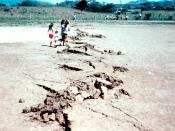In May of 1985, the Oklahoma Geological Survey installed a seismograph in the Meers Store to monitor the Meers Fault. The seismograph is able to feel movement in the Earth from far away. It has recorded earthquakes in the Indian Ocean, which is more than 10,300 miles away from Meers. The seismograph has also recorded Russian nuclear tests, a natural gas explosion in Texas, and a mine accident in Michigan. The Meers Store became "MEO - Meers Observatory" and has proven to be one of the most sensitive stations in the country.
The Meers Fault is a profound structural dislocation that forms the frontal fault zone between the Wichita Uplift up to the south and the Anadarko Basin to the north. The Meers fault is part of the Pennsylvanian Frontal Fault System. It stretches from the southeast to the northwest through south central and southwest Oklahoma and into the Texas "Panhandle."
The characteristics of the fault are very unusual for the Mid-Continental United States. A distinct fault trace is visible from near Saddle Mountain to Cache Creek for at least fifteen miles. Many scientists had believed that the last major movement occurred during the Pennsylvanian person some three hundred million years ago. However, more recent studies show the time of the last major movement occurred five hundred to two thousand years ago. The Meers Fault could produce a magnitude of seven on the Richter Scale in the future.
The fault is very "special" to Oklahomans because it is the only fault that has broken the surface of the Earth east of the Rocky Mountains. Most people would believe that the fault belongs to California, where faults are very plentiful. Scientists believe that the fault may have been formed by a major earthquake many years ago which shook the ground so...

